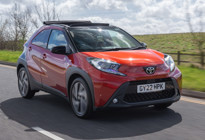Toyota RAV4 (2013 - 2019)
.jpg?width=420&height=250&rmode=crop)
Toyota RAV4 2.5 Litre Hybrid Excel 5-Door
Next-generation hybrid powertrain, ultra-economical, comfortable, off-road 4WD SUV
My 18MY RAV4 hybrid is now 6 months old with just over 6,000 miles on the clock and it continues to perform flawlessly like the 2008 X-TR 2.2D-4D it replaced. Toyota’s reputation for reliability was a major selling point for me because I originally intended to keep this car for ten years and about 100,000 miles. The car has a 5 year / 100,000 mile manufacturer’s warranty as standard with cover for the hybrid battery extendable to 10 years provided it’s inspected annually by Toyota. This is a free service for the first 5 years and then costs £38 per annum. I also paid £705 to cover all the servicing bills up to the end of the fourth year, an average of £235 per service which is marginally less than I was paying annually for the X-TR.
The RAV4 Excel version is loaded with technical features typical of a top-of-the-range car; a complete list is available at: https://www.toyota.co.uk/brochures-pricelists.json. I particularly like the adaptive cruise control feature for the added safety it brings and the way it optimises the already excellent fuel economy. The 360-degree proximity sensors are well-tuned to the physical limits of the bodywork and combine with the clear wide-screen camera display, slick gear shift and power steering to make for effortless manoeuvring in tight spots.
The keyless entry system is instinctive to use and works perfectly in all weathers while the powered rear tailgate design ensures that water drains away from the car, not down the neck or into the wheel well. Inside there’s a comprehensive dual-channel climate control system, heated front seats with electric seat adjustment and memory positions on the driver’s side. The LED main and dipped headlamps are powerful and more than a match for any weather conditions but the standard fog lights are fitted with 19W H16 halogen bulbs which look rather weak and yellow by comparison. However these are easily accessed from the wheel-arches so I quickly replaced them with after-market LEDs to match the spectrum and brightness of the dipped headlamps – total cost £30.00 from Auto Lighting, Westcott, Surrey. https://www.auto-lighting.co.uk
.
The all-wheel drive version of the RAV4 hybrid weighs 1,785 kg and will legally carry a half-ton payload for an all-up weight of 2,270 kg. The 197 HP HSD (hybrid synergy drive), which comprises a 4-cylinder petrol engine and two electric motors, will haul a braked trailer weighing 1,650 kg providing a total payload of 2,135 kg. The point here (mainly for caravan owners) is that today’s RAV4 hybrid appears to have overcome the towing problems associated with earlier hybrid cars such as the Prius. I haven’t towed anything yet so can’t comment but I can say that the removable tow-bar is easy and quick to use and represents very good value at £550 including electrics.
The hybrid’s load-space is reduced by 102 litres due to the battery housing under the rear seats but there’s still 1,633 litres overall capacity with the seats down, just 36 fewer than the 2018 Honda CR-V which, at 4605 mm, is the same length. The boot space with five occupants aboard is similar to the other 2018 RAV4 models at 547 litres.
On the motorway the RAV4 cruises quietly and effortlessly with smooth and sure-footed handling. The seats are comfortable and supportive (there’s a lumbar control on the driver’s side) and provide a nicely-elevated view of the road ahead with little obstruction noticeable from the A pillars. After a recent 380-mile drive from Cumbria my wife and I both remarked on our lack of fatigue, despite having stopped only twice for drinks and the restrooms.
On A-roads the RAV4 hybrid is stable and responsive and corners much like a saloon car with no obvious body roll; it’s assisted here by a low centre of gravity thanks to the weight of the hybrid battery pack, the rear motor and the aerodynamically-tapered roof. Power response is more than adequate in ECON mode while in SPORT it will accelerate to 60 mph in about 8 seconds with a top speed of 112 mph. It’s worth pointing out that under very hard acceleration the engine becomes quite audible creating a sensation akin to the clutch slipping on a conventional powertrain. However, on the RAV4 this is normal, just the result of the CVT selecting an optimum engine RPM for the required power output and then holding this steady while it gradually increases the gear ratio.
Around town the RAV4 really starts to distinguish itself from the pack - in nose-to-tail traffic it is the most relaxing car I have ever driven, thanks to a plethora of advanced, closely-integrated powertrain features. Firstly, there is the way it deals with stop-start traffic. It’s a petrol-electric hybrid, so the engine always stops turning when the vehicle is stationary (the exception being when the batteries need topping up). Mostly the car crawls along in electric-only mode and the engine starts up again if the torque demands on the HSD exceed the 50W power output of the electric motors. Unlike a conventional car, it doesn’t need a separate starter motor to do this. It simply siphons off some of the existing torque from the electric motor-generators and uses this to quietly spin the engine up to speed, before drawing on the additional power when it is needed. This happens in a fraction of a second and goes completely unnoticed by the driver.
Thanks to KERS, stopping the RAV4 hybrid is another refreshingly novel experience. When the driver releases the accelerator the engine stops turning immediately and overrun is simulated by the electric motors instantly switching personality to become electric generators. The slight deceleration felt by the passengers feels normal but is caused by the vehicle’s kinetic energy being used to generate electric current for topping up the batteries. If the brake pedal is pressed, the deceleration forces start to increase proportionally but this is still the result of increased KERS as the generators are asked to work harder to produce more current. The power meter indicates the optimum braking force to apply to obtain 100% KERS braking – pushing the pedal any harder than this then seamlessly engages disc braking to achieve the required deceleration. The slight down-shifting judder always felt with discrete ratio automatics is totally absent on the RAV4 hybrid thanks to the CVT’s electronic control which constantly optimises engine braking with KERS to maximise the fuel saving, prolong engine life and limit brake wear. It is a very satisfying experience physically but knowing that none of that expensive kinetic energy has been wasted really puts the icing on the cake from a technical perspective.
When it’s not stopping or starting from a standstill the RAV4 hybrid’s intelligent power management software is constantly working behind the scenes, selecting the optimum ratio and blend of petrol or electric power for the conditions in order to maximise fuel economy.Alternatively it is generating bursts of power every time the accelerator is backed off to decrease speed slightly, or when it detects any shallow down slope in the road. You can observe the HSD’s obsession with finding the best economy in a colour schematic on the touch-screen display. It really is a case of “every little helps” and this is one of the main reasons why the 2.5 litre hybrid achieves 14 mpg more than the comparable 2.0 litre petrol version and only 3 mpg less than the 2.0 litre diesel, according to the NEDC statistics. These are artificial figures of course: so what is it like in the real world? This is surely the best part of the whole story.
The fuel tank holds 56 litres, 51 litres of which (11.3 gallons) are available before the “Distance to Fuel Pump” figure has finished counting down to zero. Measured by refill quantity and odometer monitoring my average economy is currently 47.5 mpg, giving a total range of 585 miles, including 48 miles available from the one gallon reserve (the on-board computer slightly over-estimates showing 48.5 mpg). Petrol cars don’t need DEF and currently benefit from 4p/litre fuel savings so a similar diesel-powered SUV would need to average more than 50 mpg in order to meet the real-world economics of this car. By way of comparison, these are the average mpg figures I used to achieve with my personal driving style:
a) 2008 Toyota RAV4 X-TR 2.2 D-4D 143 HP Manual - average 42 mpg;
b) 2017 LR Discovery Sport SE Tech TD4 148 HP Manual - average 39 mpg.
I still find it remarkable to think that 47.5 mpg is my average fuel economy over more than 6,000 miles with the hybrid RAV4. I frequently achieve around 50 mpg during my 80 mile motorway commutes and on a section of our recent trip to the Lake District (Northampton to Keswick via M1, M18, A1(M),A66), the car returned 52.3 mpg indicated (51.1 mpg actual) using adaptive cruise control on clear roads. The extra urban figure claimed by Toyota for the AWD is 53.2 mpg so I feel completely satisfied with how this vehicle is performing on 95 octane petrol.
I have no hesitation whatsoever in recommending this vehicle but it doesn’t really need too many more plaudits having already achieved the position of 4th most popular vehicle in the USA, where more than 407,000 were sold last year alone. Fourth place in the American sales league tables is more significant than it sounds when I add that the first three vehicles in the American list of best-selling vehicles were ALL large pickup trucks: the Ford F-Series, Chevrolet Silverado, and Ram Pickup Truck.
Toyota has sold more than 10 million hybrid vehicles since 1997 and it is currently the second largest single car manufacturer in the world, shipping 10.5 million vehicles in 2017. More than one million RAV4s have been sold in Europe since its introduction in the mid-nineties and, whilst the reliability of the RAV4 has always been high (for example my 2008 XA-30 had no faults in 85,000 miles and 9 years), the record of the current model (XA-40) is simply outstanding. The HJ “What to watch for” section contains only 7 entries since its launch in 2013 and 2 minor recalls. https://www.honestjohn.co.uk/carbycar/toyota/rav4-2013/?section=good
Write your review
About this car
| Price | £22,795–£35,275 |
|---|---|
| Road Tax | Alternative fuel, C–I |
| MPG | 39.2–60.1 mpg |
| Real MPG | 79.0% |

.jpg?width=205&height=140&rmode=crop)







.jpg)





